The treatment of catatonia has been well established with trials of lorazepam and ECT. Recent treatment guidelines list these as effective in acute and chronic catatonia; however, if patients do not respond to these primary treatments, clinicians have few guidelines to guide treatments for refractory catatonia.
1,
2 Amantadine has been demonstrated to be effective in refractory catatonic schizophrenia, but little evidence exists supporting its potential use in catatonia secondary to other conditions including mood disorders.
3,
4Case: A 38-year-old male was admitted to the internal medicine service with failure to thrive and end stage renal failure with uremia requiring hemodialysis. His clinical course was notable for personal neglect and a severe decline in function over the previous 3 months due to worsening major depressive disorder. A psychiatry consult was requested from the medical team due to prominent akinetic catatonic features including severe alexithymia, immobility, speech-prompt mutism, staring, and reduced oral intake resulting in a Clinical Global Impression Scale Score of Marked Severity. The patient was not considered appropriate for trial of lorazepam due to intermittent symptomatic hypotension with systolic blood pressure of 60–90 mmHg. The patient was begun on sertraline 50 mg daily, risperidone 1 mg daily, and methylphenidate 5 mg daily, with only minimal improvement after 2 weeks, whereupon he was referred for ECT.
All psychiatric medications were discontinued on the day prior to beginning ECT. He received 18 bilateral index ECT treatments with a mean EEG-ictal seizure length of 68 sec; however, he remained markedly catatonic throughout the course of ECT. At this point the patient started amantadine 100 mg daily for 12 days with partial improvement in his catatonic symptomatology. The patient became able to answer simple questions, staring resolved, and he displayed occasional spontaneous movement, even though he continued to manifest significant speech prompt mutism and a paucity of spontaneous movement (CGI-I = Mild Improvement). The dose was increased to 100 mg twice daily, and after 2 weeks, the patient showed marked improvement with resolution of his catatonic presentation (CGI-I = Very much improved).
This case is notable in that it demonstrates an episode of catatonia responsive to amantadine in a medically ill individual that was unresponsive to multiple standard treatment modalities including treatment of the underlying depression using combination therapy with sertraline, risperidone, and methylphenidate followed by an extended trial of bilateral ECT. Amantadine has NMDA receptor antagonist activity in addition to mild dopaminergic activity, and emerging information offers preliminary evidence to suggest that amantadine may be effective in syndromes of glutamate excess such as catatonic schizophrenia.
4,
5 However, this case suggests that amantadine should also be considered in treatment refractory catatonia due to other etiologies including mood disorders unresponsive or intolerant of standard therapy.

